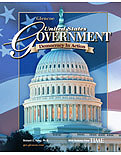
U. S. Government: Democracy In ActionChapter 23: Structure and Function of State GovernmentChapter OverviewsFrom driver's license requirements to the money available for education, state government touches your life every day. Chapter 23 explains the operations of state governments and how they impact your life. Section 1 focuses on state constitutions. Like the federal Constitution, state constitutions provide for three branches of government and protection of individual rights. State constitutions are constantly changing. In fact, all states have four ways of proposing amendments to their constitutions—by state legislature, by popular initiative, by a constitutional convention, and by a constitutional commission. Section 2 describes the states' three branches of government—legislative, executive, and judicial. All the states except Nebraska have bicameral legislatures. Each state is headed by a governor, and state court systems include one Supreme Court and many kinds of minor courts. Section 3 explores state government policy. The major areas of concern for most states include the regulation of business, the administration and control of natural resources, the protection of individual rights, and welfare programs. Section 4 examines the financing of state governments. Nearly half the general revenue of state governments comes from state taxes. Other sources of revenue are borrowing, lotteries, license fees, and the federal government. |  |















